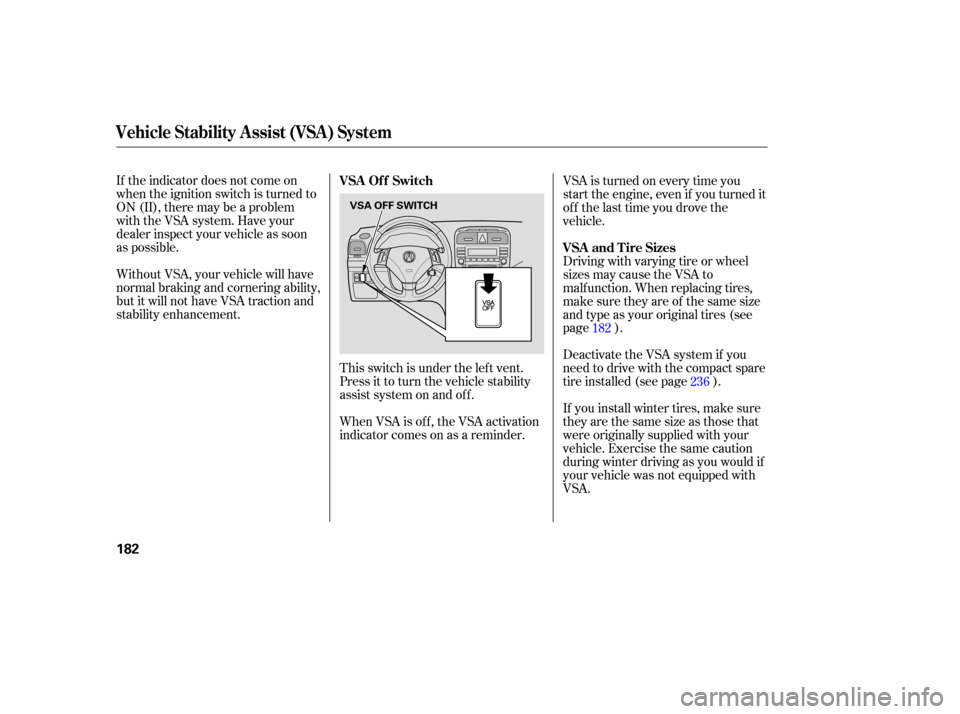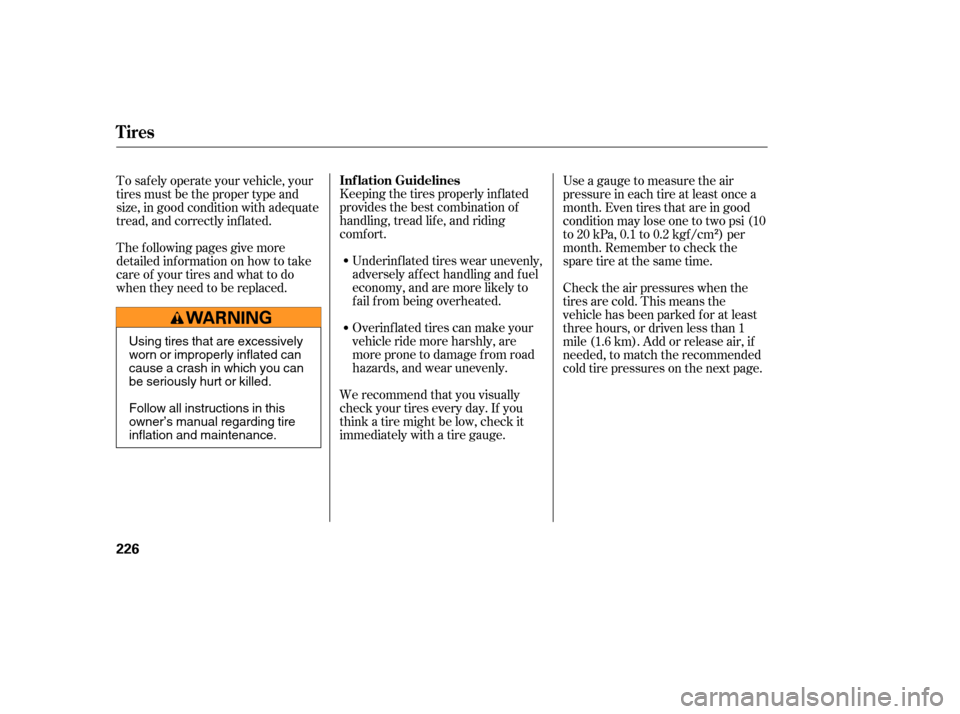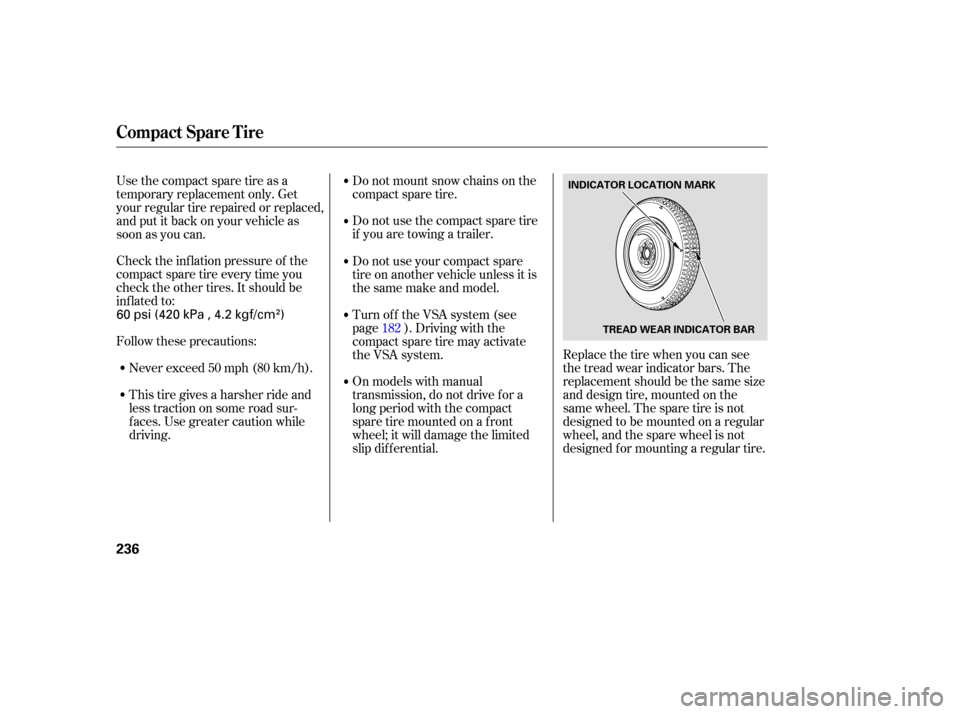spare tire Acura TSX 2005 Owner's Manual
[x] Cancel search | Manufacturer: ACURA, Model Year: 2005, Model line: TSX, Model: Acura TSX 2005Pages: 288, PDF Size: 4.14 MB
Page 183 of 288

If the indicator does not come on
when the ignition switch is turned to
ON(II),theremaybeaproblem
with the VSA system. Have your
dealer inspect your vehicle as soon
as possible.
Without VSA, your vehicle will have
normal braking and cornering ability,
but it will not have VSA traction and
stability enhancement.This switch is under the lef t vent.
Press it to turn the vehicle stability
assist system on and of f .VSA is turned on every time you
start the engine, even if you turned it
off the last time you drove the
vehicle.
Driving with varying tire or wheel
sizes may cause the VSA to
malf unction. When replacing tires,
make sure they are of the same size
and type as your original tires (see
page ).
Deactivate the VSA system if you
need to drive with the compact spare
tire installed (see page ).
If you install winter tires, make sure
they are the same size as those that
were originally supplied with your
vehicle. Exercise the same caution
during winter driving as you would if
your vehicle was not equipped with
VSA.
When VSA is off, the VSA activation
indicator comes on as a reminder. 182
236
VSA Of f Switch
VSA and Tire Sizes
Vehicle Stability Assist (VSA) System
182
VSA OFF SWITCH
Page 188 of 288

When preparing to tow, and bef ore
driving away, be sure to check the
f ollowing:The vehicle has been properly
serviced, and the tires, brakes,
suspension, cooling system, and
lights are in good operating
condition. Your vehicle tires and spare are
properly inf lated (see page ),
and the trailer tires and spare are
trailer maker.
Crosswinds and air turbulence
caused by passing trucks can disrupt
your steering and cause trailer
swaying. When being passed by a
large vehicle, keep a constant speed,
and steer straight ahead. Do not try
to make quick steering or braking
corrections. Always drive slowly and have
someone guide you when backing up.
Grip the of the steering
wheel; then turn the wheel to the lef t
to get the trailer to move to the lef t,
andturnthewheelrighttomovethe
trailer to the right.
Follow all normal precautions when
parking, including f irmly setting the
parking brake and putting the
transmission in Park (automatic) or
in 1st or Reverse (manual). Also,
place wheel chocks at each of the
trailer’s tires.
The lights and brakes on your
vehicle and the trailer are working
properly. All items in or on the trailer are
properly secured and cannot shif t
while you drive. Thehitch,safetychains,andany
other attachments are secure. All weights and loads are within
limits (see pages and ). 183 184 227
bottom
Pre-T ow Checklist
Handling Crosswinds and Buf f et ing
Backing Up
Parking
Towing a Trailer
Driving
187
Page 227 of 288

Keeping the tires properly inf lated
provides the best combination of
handling, tread lif e, and riding
comf ort.Underinf lated tires wear unevenly,
adversely affect handling and fuel
economy, and are more likely to
fail from being overheated.
Overinf lated tires can make your
vehicleridemoreharshly,are
more prone to damage f rom road
hazards, and wear unevenly.
We recommend that you visually
check your tires every day. If you
think a tire might be low, check it
immediately with a tire gauge.
To saf ely operate your vehicle, your
tires must be the proper type and
size, in good condition with adequate
tread, and correctly inf lated.
The f ollowing pages give more
detailed inf ormation on how to take
care of your tires and what to do
when they need to be replaced.
Check the air pressures when the
tires are cold. This means the
vehicle has been parked f or at least
three hours, or driven less than 1
mile (1.6 km). Add or release air, if
needed, to match the recommended
cold tire pressures on the next page. Use a gauge to measure the air
pressure in each tire at least once a
month. Even tires that are in good
condition may lose one to two psi (10
to 20 kPa, 0.1 to 0.2 kgf /cm ) per
month. Remember to check the
sparetireatthesametime.
Tires
Inf lation Guidelines
226
Using tires that are excessively
worn or improperly inflated can
cause a crash in which you can
be seriously hurt or killed.
Follow all instructions in this
owner’s manual regarding tire
inflation and maintenance.
Page 228 of 288

If you check air pressures when the
tires are hot (driven f or several
miles), you will see readings 4 to 6
psi (30 to 40 kPa, 0.3 to 0.4 kgf /cm )
higher than the cold readings. This
is normal. Do not let air out to match
the recommended cold air pressure.
The tire will be underinf lated.The following chart shows the
recommended cold tire pressures f or
most normal driving conditions.
Youshouldgetyourowntire
pressure gauge whenever you check
your tire pressures. This will make it
easier f or you to tell if a pressure
loss is due to a tire problem and not
due to a variation between gauges.
While tubeless tires have some
ability to self -seal if they are
punctured, you should look closely
for punctures if a tire starts losing
pressure. Thecompactsparetirepressureis:
For convenience, the recommended
tire sizes and cold air pressures are
on a label on the driver’s doorjamb.
For additional inf ormation about
your tires, see page .
264
Tire Size Cold Tire Pressure
for Normal Driving
Front:
Rear:
Tires
Recommended Tire Pressures
Maint enance
227
60 psi (420 kPa , 4.2 kgf/cm)
P215/50R17 93V 32 psi (220 kPa ,2.2 kgf/cm
)
30 psi (210 kPa , 2.1 kgf/cm
)
Page 236 of 288

This section covers the more
common problems that motorists
experience with their vehicles. It
gives you inf ormation about how to
safely evaluate the problem and what
to do to correct it. If the problem has
stranded you on the side of the road,
you may be able to get going again.
If not, you will also f ind instructions
on getting your vehicle towed.......................
Compact Spare Tire .236
....................
Changing a Flat Tire .237
..........
If Your Engine Won’t Start . 241
Nothing Happens or the Starter Motor Operates ............................
Very Slowly .241
The Starter Operates ................................
Normally .242
................................
Jump Starting .243
............
If Your Engine Overheats . 245
.........
Low Oil Pressure Indicator . 247
..........
Charging System Indicator . 248
.......
Malf unction Indicator Lamp . 248
.......................
Readiness Codes .249
...............
Brake System Indicator . 250
..................
Closing the Moonroof . 251
......................
Emergency Towing .252
..............................................
Fuses .254
..........
Checking and Replacing . 254
Taking Care of the Unexpected
T aking Care of t he Unexpect ed
235
Page 237 of 288

Check the inf lation pressure of the
compact spare tire every time you
check the other tires. It should be
inf lated to:
Follow these precautions:Never exceed 50 mph (80 km/h).
This tire gives a harsher ride and
less traction on some road sur-
f aces. Use greater caution while
driving. Do not mount snow chains on the
compact spare tire.
Do not use the compact spare tire
if you are towing a trailer.
Replace the tire when you can see
the tread wear indicator bars. The
replacement should be the same size
and design tire, mounted on the
same wheel. The spare tire is not
designed to be mounted on a regular
wheel, and the spare wheel is not
designed f or mounting a regular tire.
Use the compact spare tire as a
temporary replacement only. Get
your regular tire repaired or replaced,
and put it back on your vehicle as
soon as you can.
Do not use your compact spare
tire on another vehicle unless it is
thesamemakeandmodel.
On models with manual
transmission, do not drive f or a
long period with the compact
spare tire mounted on a f ront
wheel; it will damage the limited
slip dif f erential. Turn of f the VSA system (see
page ). Driving with the
compact spare tire may activate
the VSA system.182
Compact Spare Tire
236
INDICATOR LOCATION MARK
TREAD WEAR INDICATOR BAR
60 psi (420 kPa , 4.2 kgf/cm)
Page 239 of 288

Placethejackunderthejacking
point nearest the tire you need to
change. Turn the end bracket
clockwise until the top of the jack
contacts the jacking point. Make
sure the jacking point tab is
restinginthejacknotch.
Unscrew the wing bolt and take
the spare tire out of the trunk.
Loosen each wheel nut 1/2 turn
with the wheel wrench.
Open the trunk. Raise the trunk
f loor by lif ting up on the back edge.
Take the tool tray out of the trunk,
and remove the tools and the jack. 7.
3.
4. 5.
6.
Changing a Flat T ire
238
JACKING POINT
TOOL TRAY
Page 240 of 288

CONT INUED
Bef ore mounting the spare tire,
wipe any dirt of f the mounting
surface of the wheel and hub with
a clean cloth. Wipe the hub
carefully;itmaybehotfrom
driving.
Remove the wheel nuts and f lat
tire. Place the f lat tire on the
ground with the outside surf ace of
the wheel f acing up.
Use the extension and the wheel
nut wrench as shown to raise the
vehicle until the f lat tire is of f the
ground.
8. 9.
10.
Changing a Flat T ire
T aking Care of t he Unexpect ed
239
EXTENSION
BRAKE HUB
WHEEL NUT WRENCH
Page 241 of 288

Tighten the wheel nuts securely in
the same crisscross pattern. Have
the wheel nut torque checked at
the nearest automotive service
f acility.
Tighten the wheel nuts to:
Put on the spare tire. Put the
wheel nuts back on f inger-tight,
then tighten them in a crisscross
pattern with the wheel nut wrench
until the wheel is f irmly against
the hub. Do not try to tighten
them f ully.
Lower the vehicle to the ground
and remove the jack. Remove the center cap before
storing the f lat tire in the trunk
well.
Place the flat tire face down in the
spare tire well.
Remove the spacer cone f rom the
wing bolt, turn it over, and put it
back on the bolt.
Secure the f lat tire by screwing
the wing bolt back into its hole.
Store the jack and tools in the tool
tray, and place the tool tray back
in the trunk.
11.
12. 13.14.
15.
16.
17.
18.
Changing a Flat T ire
240
WING BOLT
SPACER CONEFor
normal
tire
For
spare
tire
80 lbf·ft (108 N·m , 11 kgf·m)
Page 265 of 288

Specif ications
264
TiresP215/50R17 93V
T135/80D16 101M
32 psi (220 kPa , 2.2 kgf/cm
)
60 psi (420 kPa , 4.2 kgf/cm
)
Size
Pressure
30 psi (210 kPa , 2.1 kgf/cm)
Front/Rear
Spare
Front
Rear
Spare